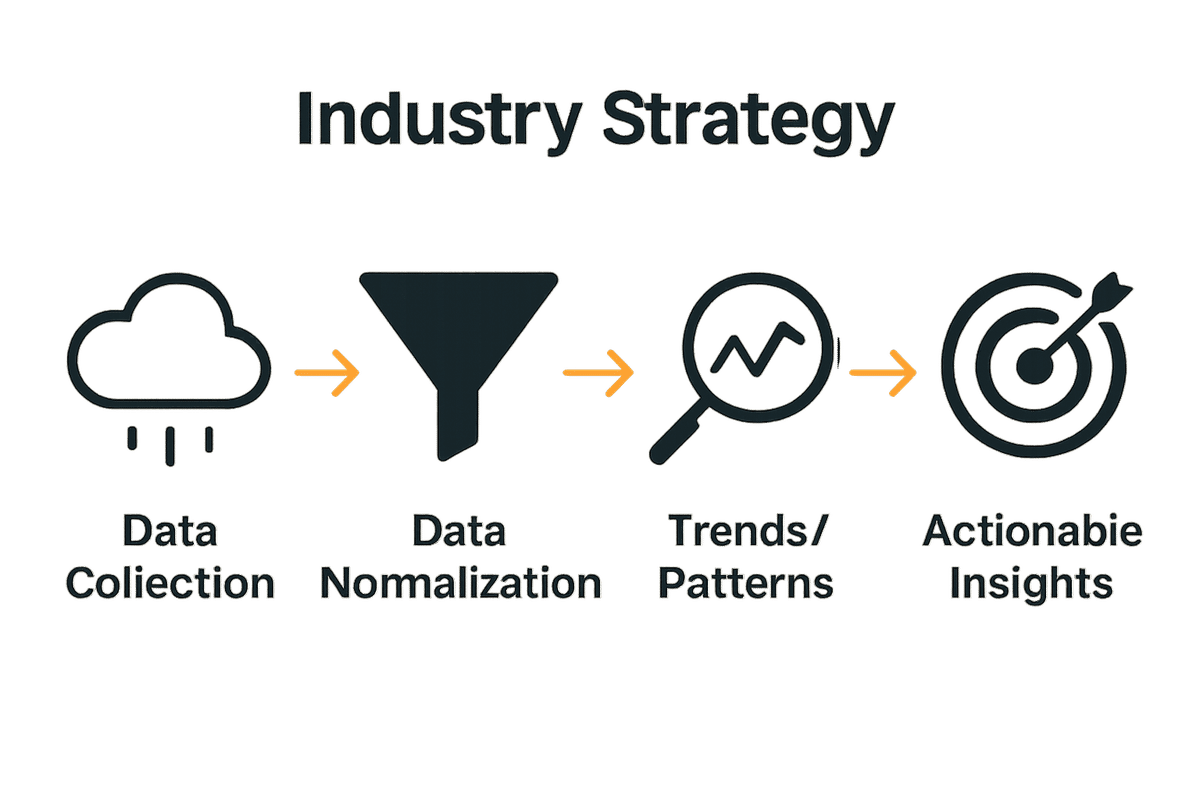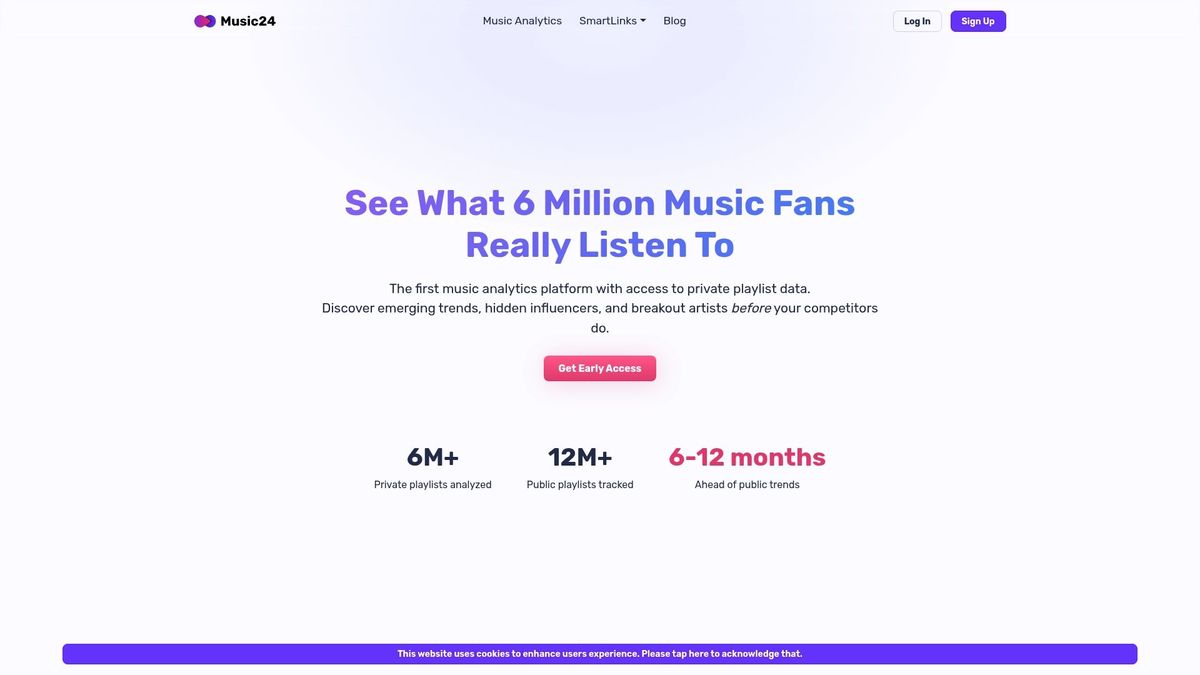Over 100 million playlists are created every day across global streaming platforms, reflecting a massive shift in how we discover music. This surge in customized listening has quietly redefined the way artists are promoted and how trends emerge. By turning raw playlist data into valuable insights, professionals can now predict rising stars and understand new musical tastes with remarkable accuracy.
Table of Contents
- Defining Playlist Analytics Workflow Fundamentals
- Key Data Sources and Private Playlists
- Step-By-Step Playlist Analytics Process
- Detecting Trends, Influencers, and Breakout Artists
- Essential Use Cases for Music Professionals
- Common Workflow Pitfalls and Optimization Tips
Key Takeaways
| Point | Details |
|---|---|
| Playlist Analytics Workflow | A systematic approach that transforms raw playlist data into actionable insights for strategic decision-making in the music industry. |
| Importance of Context | Understanding song context and order is crucial for enhancing recommendation quality and user engagement. |
| Significance of Private Playlists | Analyzing private playlists provides deeper insights into listener preferences and emerging trends often missed in public data. |
| Optimization Strategies | Addressing common workflow pitfalls and integrating advanced analytical techniques can enhance the effectiveness of playlist analytics. |
Defining Playlist Analytics Workflow Fundamentals
Playlist analytics workflow represents a systematic approach to understanding and leveraging music consumption patterns through comprehensive data analysis. At its core, the workflow transforms raw playlist data into actionable insights that music industry professionals can use to make strategic decisions about artist promotion, audience targeting, and genre trends.
According to research from arXiv, the critical foundation of playlist analytics involves examining song context and order, which significantly impacts recommendation quality and user engagement. The study highlights that understanding the sequence and relationship between tracks is not just a technical challenge but a nuanced art of musical curation.
The workflow typically encompasses several key stages that enable music professionals to extract meaningful intelligence:
- Data Collection: Gathering playlist data from multiple streaming platforms
- Contextual Analysis: Examining track placement, genre transitions, and listener behavior
- Pattern Recognition: Identifying emerging trends and listener preferences
- Strategic Insights: Translating data findings into actionable music industry strategies
Understanding the Music Analytics Workflow for Success reveals that successful playlist analytics requires a multidimensional approach. As research from arXiv suggests, modern playlist analytics frameworks must be scalable and capable of preserving musical characteristics while aligning with diverse user preferences.
Advanced playlist analytics workflows go beyond simple track counting. They involve sophisticated algorithms that can predict listener behavior, understand complex musical relationships, and provide predictive models for music discovery. This approach transforms raw data into a strategic tool for artists, labels, and music industry professionals seeking to understand and leverage the intricate dynamics of music consumption.
Key Data Sources and Private Playlists
Private playlists represent a hidden goldmine of music consumption data that traditional analytics often overlook. These personal collections offer unprecedented insights into listener preferences, genre blending, and emerging music trends that are not visible through public streaming metrics.
Understanding Private Playlist Data reveals the nuanced landscape of private playlist analysis. According to Google Developers, comprehensive playlist performance metrics go beyond simple view counts, encompassing critical dimensions like watch time, engagement patterns, and listener interaction rates.
Key data sources for private playlist analytics include:
- Streaming Platform APIs: Anonymized data collection from major music services
- User Behavior Tracking: Anonymous interaction metrics within playlist environments
- Metadata Extraction: Analyzing track relationships, genre transitions, and playlist architectures
- Cross-Platform Integration: Synthesizing data from multiple streaming ecosystems
The strategic value of private playlist data lies in its ability to capture authentic listener behavior before it becomes mainstream. Unlike public playlists, these personal collections reveal unfiltered music discovery patterns, allowing music industry professionals to identify emerging artists and predict future trends with unprecedented accuracy.
Professional music analytics workflows must recognize that private playlists are not just data points but complex musical ecosystems. They represent individual listeners' musical journeys, reflecting nuanced preferences that cannot be captured through traditional chart-based analytics.
 By understanding these intricate personal collections, music industry professionals can develop more targeted, personalized strategies for artist development and audience engagement.
By understanding these intricate personal collections, music industry professionals can develop more targeted, personalized strategies for artist development and audience engagement.
Step-By-Step Playlist Analytics Process
The playlist analytics process is a structured methodology that transforms raw music data into strategic insights. Music industry professionals must approach this workflow systematically, ensuring each stage delivers meaningful intelligence about listener behavior and musical trends.
Understanding Playlist Analytics Strategy highlights the importance of a comprehensive approach. According to Coefficient, efficient data analysis requires sophisticated tools that can seamlessly import and process playlist metrics across different platforms.
The step-by-step playlist analytics process typically involves these critical stages:
Here's a summary of the main playlist analytics workflow stages and their key objectives:
| Stage | Key Activities | Main Objective |
|---|---|---|
| Data Collection | Extract from platforms Aggregate user metrics | Gather comprehensive playlist data |
| Data Normalization | Standardize formats Remove duplicates | Ensure accurate and clean datasets |
| Pattern Recognition | Analyze genre shifts Detect listener trends | Uncover hidden musical patterns |
| Insights Generation | Build predictive models Create audience segments | Deliver actionable intelligence for strategy |
- Data Collection
- Extract playlist data from multiple streaming platforms
- Aggregate anonymized user interaction metrics
- Capture track metadata and listener engagement signals
- Data Normalization
- Standardize data formats across different sources
- Remove duplicate or inconsistent entries
- Prepare data for advanced analytical processing
- Pattern Recognition
- Identify genre transition patterns
- Analyze track sequence and listener retention
- Detect emerging musical trends and micro-genres
- Insights Generation
- Develop predictive models for music discovery
- Create audience segmentation frameworks
- Generate actionable recommendations for artists and labels

Advanced playlist analytics go beyond simple metrics. Playlist Analytics Examples demonstrates how professional workflows can uncover hidden patterns in listener behavior. By leveraging sophisticated analytical techniques, music industry professionals can predict emerging artists, understand complex musical preferences, and develop targeted promotional strategies that resonate with specific audience segments.
The ultimate goal of playlist analytics is transforming raw data into strategic intelligence.
This approach allows music industry professionals to move beyond traditional metrics, creating a more nuanced understanding of how listeners discover, consume, and share music in an increasingly complex digital landscape.
Detecting Trends, Influencers, and Breakout Artists
Music trend detection represents a sophisticated process of identifying emerging artists, sonic innovations, and influential playlist curators before they become mainstream. This strategic approach transforms raw data into predictive intelligence that music industry professionals can leverage for artist development and marketing strategies.
How to Detect Music Trends Early underscores the complexity of trend identification. According to research from arXiv, advanced machine learning techniques like reinforcement-learning agents can model user preferences and track transitions, providing unprecedented insights into musical discovery patterns.
Key strategies for detecting trends and breakout artists include:
-
Playlist Composition Analysis
-
Track frequency and sequence patterns
-
Genre transition indicators
-
Emerging artist visibility metrics
-
Curator Influence Mapping
-
Identify playlist creators with consistent trend-setting behavior
-
Analyze cross-platform playlist performance
-
Track playlist evolution and musical recommendation patterns
Recent research from arXiv demonstrates how recurrent neural networks can enhance playlist generation algorithms, enabling more sophisticated tracking of musical innovations and artist emergence. These advanced analytical techniques go beyond traditional metrics, capturing nuanced listener behaviors that signal potential breakthrough moments.
The most successful trend detection workflows combine quantitative data analysis with qualitative musical understanding. By synthesizing algorithmic insights with human expertise, music industry professionals can anticipate shifts in listener preferences, identify promising emerging artists, and develop targeted strategies that capitalize on nascent musical movements before they become widely recognized.
Essential Use Cases for Music Professionals
Playlist analytics has transformed from a niche technical practice to a critical strategic tool for music industry professionals. By leveraging data-driven insights, artists, managers, labels, and marketers can make precise, informed decisions that dramatically enhance their strategic approaches.
Understanding the Benefits of Music Analytics highlights the transformative potential of data analysis. According to Zigpoll, optimizing playlist placement strategies is crucial for maximizing engagement and visibility across different music platforms.
Essential use cases for music professionals include:
For Artist Managers
- Track artist growth and audience expansion
- Identify optimal touring and promotion strategies
- Monitor competitive landscape and audience demographics
For Record Labels
- Discover and validate emerging talent
- Develop targeted marketing campaigns
- Predict potential breakout artists
For A&R Professionals
- Analyze genre-crossing trends
- Evaluate artist potential through playlist performance
- Understand listener preferences and musical ecosystems
For Music Marketers
- Create data-driven promotional strategies
- Segment audiences with precision
- Measure campaign effectiveness in real-time
The most successful music professionals view playlist analytics not as a technical exercise, but as a strategic intelligence tool. By understanding the nuanced patterns of listener behavior, they can anticipate market shifts, develop targeted strategies, and create more meaningful connections between artists and audiences.
Ultimately, playlist analytics provides a competitive edge in an increasingly complex and data-driven music landscape. Professionals who master these insights can transform raw data into powerful strategic advantages, driving innovation and success across the music industry.
Common Workflow Pitfalls and Optimization Tips
Playlist analytics workflows are complex ecosystems prone to strategic missteps that can significantly undermine data-driven decision making. Music industry professionals must navigate these challenges with precision and understanding to extract meaningful insights from their analytical processes.
Data Calculus provides a comprehensive framework for addressing common workflow challenges. According to their research, successful playlist analytics requires a systematic approach that goes beyond surface-level metrics and penetrates the nuanced landscape of listener behavior.
Common workflow pitfalls include:
Data Collection Errors
- Incomplete or inconsistent data sampling
- Overlooking niche platforms and emerging streaming services
- Failing to account for regional variations in listener preferences
Analytical Limitations
- Relying exclusively on public streaming metrics
- Ignoring context and sequence of playlist tracks
- Neglecting qualitative aspects of musical discovery
Optimization Strategies
- Implement multi-platform data aggregation
- Develop robust normalization techniques
- Create adaptive analytical models
- Integrate machine learning for predictive insights
Neutopia Analytics emphasizes the importance of understanding user engagement patterns beyond traditional metrics. Successful professionals recognize that playlist analytics is not just about numbers, but about decoding the complex ecosystem of musical preferences.
Ultimately, optimizing playlist analytics workflows requires a holistic approach that balances technological sophistication with human musical intuition. By acknowledging potential pitfalls and implementing strategic refinement techniques, music industry professionals can transform raw data into powerful, actionable intelligence that drives meaningful artistic and commercial outcomes.
Unlock the Power of Private Playlist Analytics for Your Music Strategy
The article highlights the challenges professionals face in accurately detecting emerging trends, influential curators, and breakout artists using traditional public metrics alone. It points out the vital need to analyze private playlist data and understand complex listener behavior through a structured playlist analytics workflow that goes beyond surface-level numbers. If you are seeking to transform raw playlist data into predictive insights, identify authentic music discovery patterns, and develop precise marketing strategies you are facing the exact challenges that Music24.com was built to solve.

Experience firsthand how Music24.com leverages millions of anonymized private playlists to deliver deep insights on genre blending, geographic micro-trends, and curator influence. This unique access lets you discover rising artists and evolving musical movements before they hit mainstream charts. Visit Music24.com now to harness predictive analytics designed for record labels, artist managers, A&R teams, and music marketers who want to stay ahead. Explore how our platform makes early artist discovery and audience segmentation simple by visiting Music24.com and learn more about how to detect music trends early. Don’t wait until everyone else sees it first. Take control of your playlist analytics workflow today.
Frequently Asked Questions
What is playlist analytics workflow?
Playlist analytics workflow is a systematic process that transforms raw music data into actionable insights. It helps music professionals understand consumption patterns, track relationships, and audience engagement, enabling better strategic decisions for artist promotion and marketing.
What are the key stages in the playlist analytics process?
The key stages include Data Collection, Data Normalization, Pattern Recognition, and Insights Generation. Each stage focuses on different aspects of music consumption data, from gathering information to deriving actionable strategies.
How can private playlists be valuable for playlist analytics?
Private playlists provide unique insights into listener preferences and emerging trends that are not visible through public metrics. They capture genuine user behavior, which helps industry professionals identify breakthrough artists and predict shifts in music consumption.
What common pitfalls should be avoided in playlist analytics workflows?
Common pitfalls include data collection errors, overlooking niche platforms, and relying solely on public streaming metrics. Optimization strategies involve multi-platform data aggregation, robust normalization techniques, and integrating machine learning for enhanced insights.
Recommended
- Understanding the Music Analytics Workflow for Success - Blog - Music24.com
- Step by Step Music Analytics Process for Industry Success - Blog - Music24.com
- 7 Essential Tips for Your Music Analytics Checklist - Blog - Music24.com
- Understanding Playlist Analytics Strategy for Music Industry - Blog - Music24.com
- Ambeone student's Data Science project Predicting Music trends


